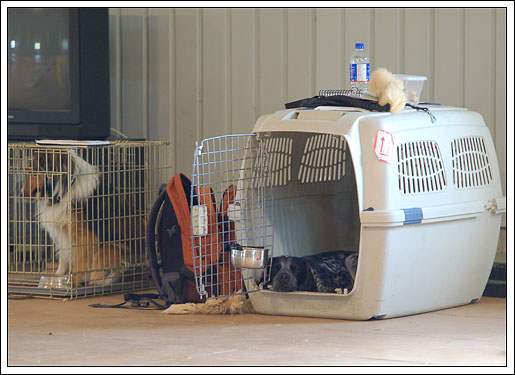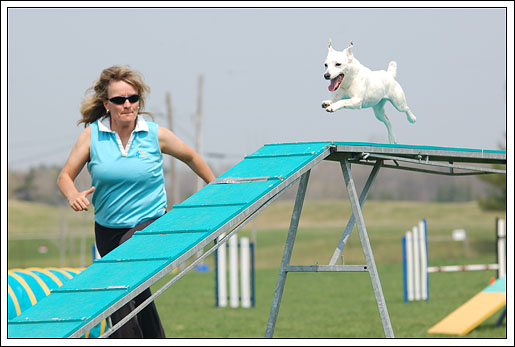Jump workshop
We have been to a two-and-a-half-day workshop on jumping with Vappu Alatalo. Vappu has trained with Susan Salo and is teaching her stuff. This was an advanced workshop for those who went to a workshop in February (wich I didn’t because I was in Florida, but I sent Thomas with Missy). Missy was a superstar in the Februray workshop and she has been doing great at home as well. Shejpa, on the other hand, has been hopeless and just really sloppy and crashing through the grids at home. I really didn’t know what to do with her. On the other hand – Shejpa has been jumping all right when we have been sequencing and Missy has knocked a lot of bars, so I didn’t really know what to think and god pretty frustrated with the whole jump training.
It’s good to attend a workshop when you’re confused. I have learned a lot this weekend! Doing more advanced grids has given me a lot more understanding of how to bridge the gap between the basics and running sequences. I love working with jumping because it brings out functional, harmonic movements and because I get to train my eye and really watch dogs move. When I got home and watched some old videos of my dogs doing agility, it was like watching them jump in slow motion. I saw so much more than I used to! I am convinced that doing this kind of training is both good for performance on course, but also to keep dogs fresh and healthy throughout their career. Not everybody here agrees with me on that.
Shejpa started the workshop with a basic grid in her usual style – sloppy and crazy. But we acctually found out why she has gotten worse and worse at home. It’s too easy for her to do the same old basic stuff all the time. She gets sloppy when there is nothing for her to thunk about. She was a different dog when we changed some things and gave her challenges. Vappu was very impressed with her and thought she was a great agility dog. Shejpa did all grids in a nice way, but often failed on the first attempt and then changed and did great the second time. This is what we’re going to work on. Give her different grids and wait for her to start doing it right from the beginning. I think it’s important to not give her the same thing again if she is successful. She will get nonchalant and not do as well. I need to change something (visual appearance for example) every time she has been correct. I have also thought that Shejpa sometimes doesn’t extend well in her rear when she’s jumping. Vappu said that she did extend, but that her personal jumping style was to pull her hind legs early to prepare for a fast take off when landing – and that that style was fast and not problematic. Sounds nice.
Missy is still jumping well, but she needs a lot of proofing when it comes to my movement. She was more extreme than she usually is at home and reacted a lot to any movement from me. This is probably the biggest reason why my nicely jumping dog is knocking a lot of bars when we run together. This will take a lot of time to fix, but I feel that I have better understanding now and that I feel motivated to do something about it. Both my dogs need more work on distance grids as well. I have hardly done any with them and it shows.
I am very happy with how well my dogs are using their bodies and how well they kept fresh during three days of training. The dogs get so tired from this kind of training that you almost can’t believe it. But my dogs handled it well. Warming up and cooling down two dogs gave me a lot of excercise as well – about two hours of walking every day. I was more tired than them after the work shop ended on tuesday.




